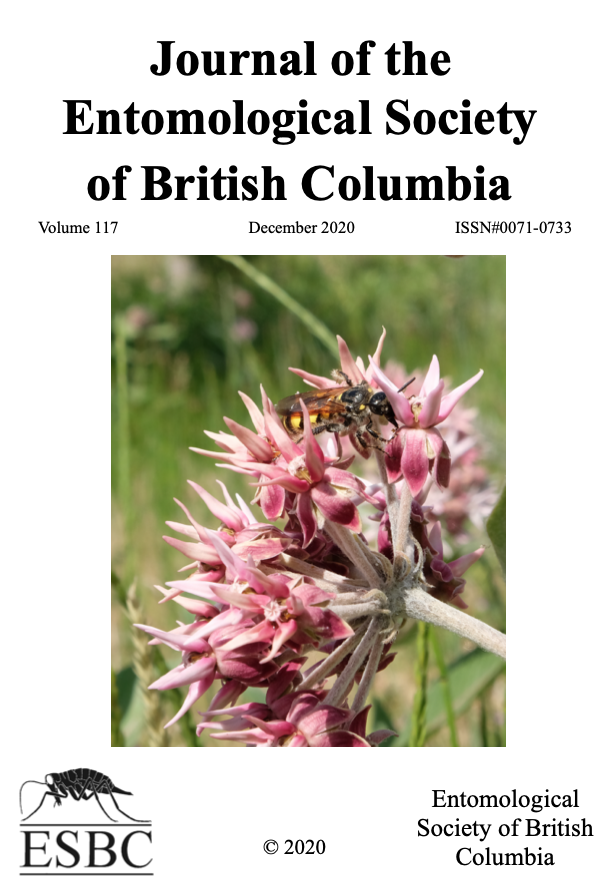Geographic range and seasonal occurrence in British Columbia of two exotic ambrosia beetles as determined by semiochemical-based trapping
Keywords:
exotic ambrosia beetles, Trypodendron domesticum, Xyloterinus politus, British ColumbiaAbstract
Two exotic ambrosia beetles, Trypodendron domesticum (L.) and Xyloterinus politus (Say) (Coleoptera: Curculionidae: Scolytinae), were captured in 2004 in traps baited with either ethanol alone or ethanol and the aggregation pheromone lineatin at locations outside their known range. The range of T. domesticum in British Columbia is now known to extend along lower Fraser Valley as far north as Yale and along the Highway 3 corridor as far east as Sunshine Valley. Xyloterinus politus was not recovered east of Hope but was trapped as far north as North Bend in the Fraser River Canyon. Neither species was found on the Sunshine Coast or on Vancouver Island. Traps on the Simon Fraser University (SFU) campus captured T. domesticum as early as the week ending 17 February 2004. At both SFU and the University of British Columbia’s Malcolm Knapp Research Forest (MKRF) in Maple Ridge, the majority of T. domesticum were captured well before peak flight of the native striped ambrosia beetle, Trypodendron lineatum (Olivier). The flight of X. politus occurred much later, spanning the months of April and May. Catches of 4,716 T. domesticum in three traps at SFU and 59 X. politus at the MKRF indicate successful establishment of both species. In future, the presence of both species will demand expert taxonomic identification as a prerequisite to implementation and interpretation of pest management tactics to prevent ambrosia beetle damage on conifer and hardwood logs and lumber.
References
Borden, J.H. 1988. The striped ambrosia beetle. In Dynamics of forest insect populations. Edited by A.A. Berryman. Plenum, New York. Pp. 579–596.
Bright, D.E.J. 1976. The insects and arachnids of Canada, Part 2: The bark beetles of Canada and Alaska, (Coleoptera: Scolytidae). Canada Department of Agriculture, Ottawa. Publication No. 1576.
FPInnovations. (n.d.). Red Alder: Alnus rubra, Bong. Fact Sheet. Forintek Canada Corp. Vancouver, BC.
Gaubicher, B., De Proft, M., and Gregoire, J.-C. 2003. Trypodendron domesticum and Trypodendron signatum: two scolytid species involved in beech decline in Belgium. In Ecology, survey and management of forest insects, Proceedings of the joint IUFRO meeting of Working Parties S7.03.06 “Integrated management of forest defoliating insects” and S7.03.07 “Population dynamics of forest insects”, Kraków, Poland, September 1–5, 2002. Edited by M.L. McManus and A.M. Liebhold. United States Department of Agriculture, Forest Service, Northeastern Research Station. General Technical Report NE-311. Pp. 134–135.
Haack, R.A. and Rabaglia, R.J. 2013. Exotic bark and ambrosia beetles in the USA: potential and current invaders. In Potential invasive pests of agricultural crop species. Edited by J. Penna. CAB International, Wallingford, U.K. Pp. 48–74.
Henry, L. 2004. Abundance and attack rate of exotic and native wood-boring insects in southwest British Columbia. Bachelor of Science Honors thesis, University of Victoria, Victoria, BC.
Humble, L.M. 2001. Invasive bark and wood-boring beetles in British Columbia, Canada. In Protection of world forests from insect pests: advances in research, papers presented at the XXI IUFRO World Congress, Kuala Lumpur. Edited by RI. Alfaro, K. Day, S. Salom, K.S.S. Nair, H. Evans, A. Liebhold, F. Lieutier, M. Wagner, K. Futai and K. Suzuki. IUFRO World Series Vol. 11, Vienna, Austria. Pp. 69–77.
Klimetzek, D., Vité, J.P., and König, E. 1981. Über das Verhalten mitteleurpäischer Trypodendron-Arten gegen gegenüber natürlichen und synthetischen Lockstoffen. Allegmeine Forst- und Jagdzeitung, 152: 64–70.
Kühnholz, S., Borden, J.H., and McIntosh, R.L. 2000. The ambrosia beetle, Gnathotrichus retusus (Coleoptera: Scolytidae), breeding in red alder, Alnus rubra (Betulaceae). Journal of the Entomological Society of British Columbia, 97: 103–104.
Lindgren, B.S. 1983. A multiple funnel trap for scolytid beetles (Coleoptera). The Canadian Entomologist, 115: 299–302.
Lindgren, B.S. and Fraser, R.G. 1994. Control of ambrosia beetle damage by mass trapping at a dryland sorting area in British Columbia. Forestry Chronicle, 70: 159–163.
MacConnell, J.G., Borden, J.H., Silverstein, R.M., and Stokkink, E. 1977. Isolation and tentative identification of lineatin, a pheromone from the frass of Trypodendron lineatum (Coleoptera: Scolytidae). Journal of Chemical Ecology, 3: 549–561.
Mudge, A.D., LaBonte, J.R., Johnson, K.J.R., and LaGasa. E.H. 2001. Exotic woodboring
Coleoptera (Micromalthidae, Scolytidae) and Hymenoptera (Xiphydriidae) new to Oregon and
Washington. Proceedings of the Entomological Society of Washington, 103: 1011–1019.
Nijholt, W.W. 1981. Ambrosia beetles in alder. Canadian Forestry Service Research Notes 1 (2): 12. Payne, T.L., Klimetzek, D., Kohnle, U., and Mori, K. 1983. Electrophysiological and field responses of
Trypodendron spp. to enantiomers of lineatin. Journal of Applied Entomology, 95: 272–276. Petercord, R. 2006. Der Flugverauf des Laubnutholzborenkäfers Trypodendron domesticum L. 2002 bis 2004. Mitteilungen der Deutschen Gesellschaft für allgemeine und angewandte Entomologie, 15:
–223.
Schurig, V., Weber, R., Klimetzek, D., Kohnle, U., and Mori, K. 1982. Enantiomeric composition of
‘Lineatin’ in three sympatric ambrosia beetles. Naturwissenschaften, 69: 602–603.
Wood, S.L. 1982. The bark and ambrosia beetles of North and Central America (Coleoptera: Scolytidae), a taxonomic monograph. Great Basin Naturalist Memoirs No. 6, Bringham Young University,
Provo, Utah.
Downloads
Published
Issue
Section
License
Authors who publish with the Journal of the Entomological Society of British Columbia agree to the following terms:
-Authors retain copyright and grant the journal right of first publication with the work simultaneously licensed under a Creative Commons Attribution License that allows others to share the work with an acknowledgement of the work's authorship and initial publication in this journal.
-Authors are able to enter into separate, additional contractual arrangements for the non-exclusive distribution of the journal's published version of the work (e.g., post it to an institutional repository or publish it in a book), with an acknowledgement of its initial publication in this journal.
-Authors are permitted and encouraged to post their work online (e.g., in institutional repositories or on their website) prior to and during the submission process, as it can lead to productive exchanges, as well as earlier and greater citation of published work (See The Effect of Open Access).


